check engine light FIAT PANDA 2009 169 / 2.G User Guide
[x] Cancel search | Manufacturer: FIAT, Model Year: 2009, Model line: PANDA, Model: FIAT PANDA 2009 169 / 2.GPages: 226, PDF Size: 5.29 MB
Page 147 of 226
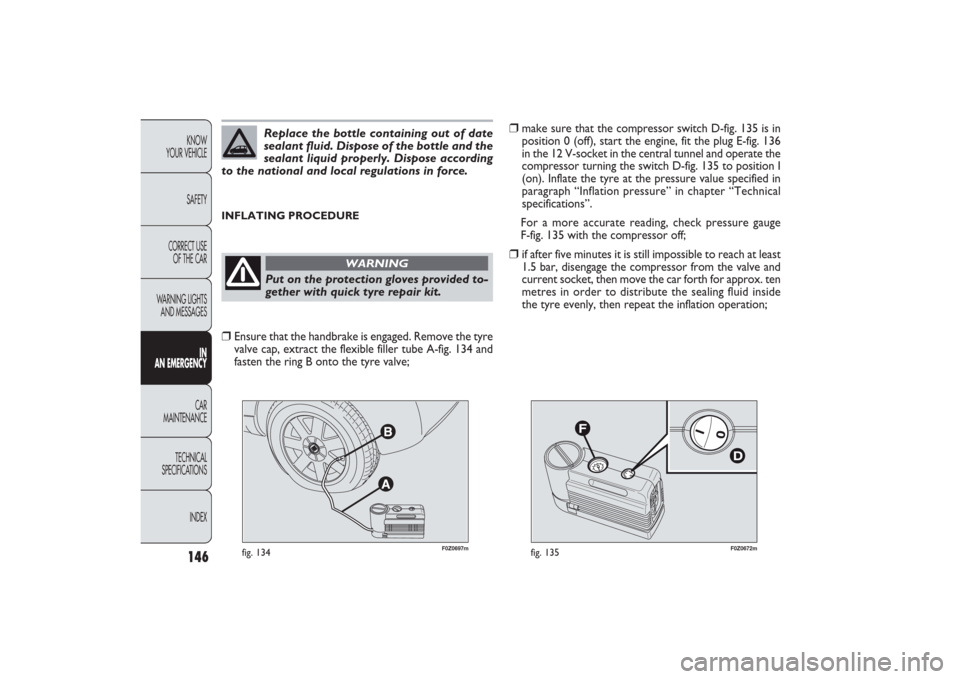
146KNOW
YOUR VEHICLE
SAFETY
CORRECT USE
OF THE CAR
WARNING LIGHTS
AND MESSAGES
IN
AN EMERGENCYCAR
MAINTENANCE
TECHNICAL
SPECIFICATIONS
INDEX
F0Z0697m
fig. 134
F0Z0672m
fig. 135
❒
make sure that the compressor switch D-fig. 135 is in
position 0 (off), start the engine, fit the plug E-fig. 136
in the 12 V-socket in the central tunnel and operate the
compressor turning the switch D-fig. 135 to position I
(on). Inflate the tyre at the pressure value specified in
paragraph “Inflation pressure” in chapter “Technical
specifications”.
For a more accurate reading, check pressure gauge
F-fig. 135 with the compressor off;
❒
if after five minutes it is still impossible to reach at least
1.5 bar, disengage the compressor from the valve and
current socket, then move the car forth for approx. ten
metres in order to distribute the sealing fluid inside
the tyre evenly, then repeat the inflation operation;
INFLATING PROCEDURE
Replace the bottle containing out of date
sealant fluid. Dispose of the bottle and the
sealant liquid properly. Dispose according
to the national and local regulations in force.Put on the protection gloves provided to-
gether with quick tyre repair kit.
WARNING
❒
Ensure that the handbrake is engaged. Remove the tyre
valve cap, extract the flexible filler tube A-fig. 134 and
fasten the ring B onto the tyre valve;
135-168 PANDA EN 7-10-2009 14:07 Pagina 146
Page 148 of 226

147KNOW
YOUR VEHICLE
SAFETY
CORRECT USE
OF THE CAR
WARNING LIGHTS
AND MESSAGESIN
AN EMERGENCYCAR
MAINTENANCE
TECHNICAL
SPECIFICATIONS
INDEX
F0Z0673m
fig. 136
F0Z0698m
fig. 137
❒
if after this operation it is still not possible to reach at
least 1.8 bar after five minutes, do not start driving since
the tyre is excessively damaged and the fast tyre re-
pair kit cannot guarantee suitable sealing. Contact
a Fiat Dealership;
❒
if the tyre reaches the pressure specified in “Inflation
pressure” paragraph in the “Technical Specifications”
chapter, start driving immediately;
Apply the adhesive label in a position
clearly visible by the driver as a reminder
that the tyre has been treated with the quick re-
pair kit. Drive carefully, particularly on bends. Do
not exceed 80 km/h. Do not accelerate and brake
suddenly.
WARNING
❒
after driving for about 10 minutes stop and check the
tyre pressure again; remember to engage the handbrake;
If the pressure falls below 1.8 bar, do not
drive any further: the quick tyre repair kit
Fix & Go automatic cannot guarantee proper hold
because the tyre is too much damaged. Contact
a Fiat Dealership.
WARNING
❒
if at least 1.8 bar pressure is read, restore proper pres-
sure (with engine running and handbrake on) and
restart;
❒
drive with the utmost care to the nearest Fiat Dealer-
ship.
135-168 PANDA EN 7-10-2009 14:07 Pagina 147
Page 171 of 226

●●●● ● ●●●●
●●●● ● ●●●●
●●●● ● ●●●●
●●●● ● ●●●●
●●●● ● ●●●●
●●●
●●●● ● ●●●●
●●●● ● ●●●●
●
●● ●●
●● ●●
●● ●●
●●20 40 60 80 100 120 140 160 180
SCHEDULED SERVICING PROGRAMMEThese coupons have to be carried out every 20,000 km
Thousands of km
Check tyre condition/wear and, if necessary, adjust
pressure
Check lighting system operation (headlights, direction indicators,
hazard warning lights, passenger’s compartment lights, boot lights, instrument panel warning lights, etc.)Check windscreen wiper/washer operation, adjust nozzlesCheck windscreen/rear window blade position/wearCheck front disc brake pad conditions and wearCheck rear drum brake linings conditions and wear
Condition visual check: bodywork exterior, underbody
protection, pipes and hoses (exhaust – fuel supply system
– braking system), rubber elements (boots – sleeves – bushes – etc...)
Check cleanliness of bonnet and boot locks, as well as cleanliness and lubrication of linkages
Check tension and conditions of various accessory drive belts (except for engines with automatic tensioners)Visually inspect conditions of the accessory drive beltsCheck and adjust tappet clearance (petrol versions)Check and adjust handbrake lever stroke Check anti-evaporation system (petrol versions)
INDEX TECHNICAL
SPECIFICATIONSCAR
MAINTENANCEIN
AN EMERGENCY WARNING LIGHTS
AND MESSAGESCORRECT USE
OF THE CARSAFETYKNOW
YOUR VEHICLE
170
169-190 PANDA EN 7-10-2009 14:14 Pagina 170
Page 172 of 226
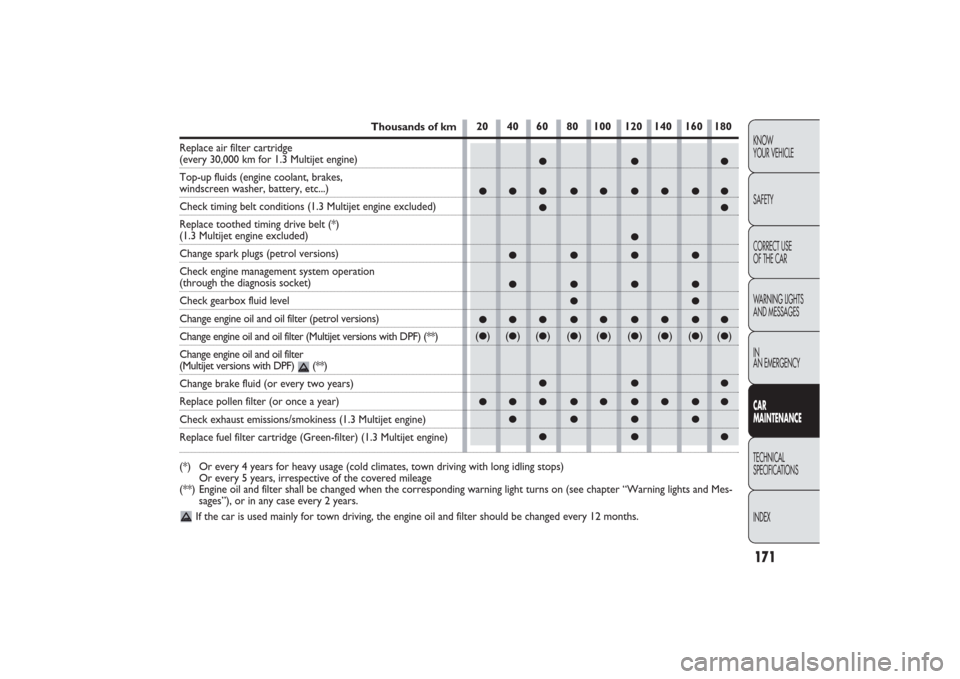
●●●
●●● ●● ●● ●●
●●
●
●●●●
●●●●
●●
●●● ●● ●● ●●
(●)(
●)(
●)(
●)(
●)(
●)(
●)(
●)(
●)
●●●
●●● ●● ●● ●●
●●●●
●●●
20 40 60 80 100 120 140 160 180
Thousands of km
Replace air filter cartridge
(every 30,000 km for 1.3 Multijet engine)
Top-up fluids (engine coolant, brakes, windscreen washer, battery, etc...)Check timing belt conditions (1.3 Multijet engine excluded)
Replace toothed timing drive belt (*) (1.3 Multijet engine excluded)Change spark plugs (petrol versions)
Check engine management system operation (through the diagnosis socket)Check gearbox fluid levelChange engine oil and oil filter (petrol versions)Change engine oil and oil filter (Multijet versions with DPF) (**)
Change engine oil and oil filter (Multijet versions with DPF) (**)Change brake fluid (or every two years)Replace pollen filter (or once a year)Check exhaust emissions/smokiness (1.3 Multijet engine)Replace fuel filter cartridge (Green-filter) (1.3 Multijet engine)
(*) Or every 4 years for heavy usage (cold climates, town driving with long idling stops)
Or every 5 years, irrespective of the covered mileage
(**) Engine oil and filter shall be changed when the corresponding warning light turns on (see chapter “Warning lights and Mes-
sages”), or in any case every 2 years.
If the car is used mainly for town driving, the engine oil and filter should be changed every 12 months.
INDEX TECHNICAL
SPECIFICATIONSCAR
MAINTENANCEIN
AN EMERGENCY WARNING LIGHTS
AND MESSAGES CORRECT USE
OF THE CAR SAFETY KNOW
YOUR VEHICLE171
169-190 PANDA EN 7-10-2009 14:14 Pagina 171
Page 173 of 226
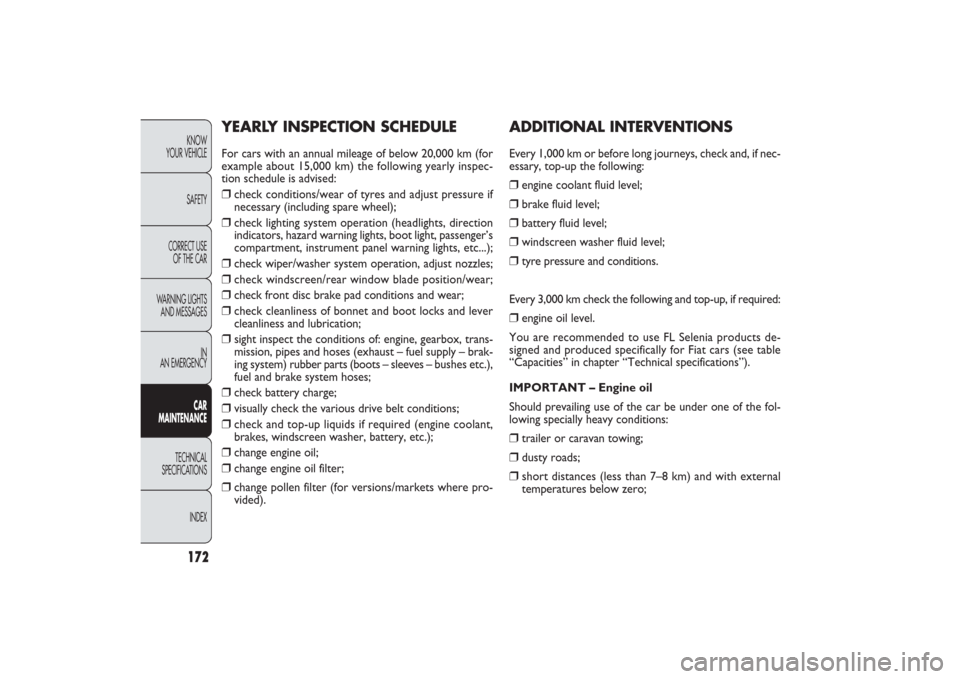
YEARLY INSPECTION SCHEDULEFor cars with an annual mileage of below 20,000 km (for
example about 15,000 km) the following yearly inspec-
tion schedule is advised:❒
check conditions/wear of tyres and adjust pressure if
necessary (including spare wheel);
❒
check lighting system operation (headlights, direction
indicators, hazard warning lights, boot light, passenger’s
compartment, instrument panel warning lights, etc...);
❒
check wiper/washer system operation, adjust nozzles;
❒
check windscreen/rear window blade position/wear;
❒
check front disc brake pad conditions and wear;
❒
check cleanliness of bonnet and boot locks and lever
cleanliness and lubrication;
❒
sight inspect the conditions of: engine, gearbox, trans-
mission, pipes and hoses (exhaust – fuel supply – brak-
ing system) rubber parts (boots – sleeves – bushes etc.),
fuel and brake system hoses;
❒
check battery charge;
❒
visually check the various drive belt conditions;
❒
check and top-up liquids if required (engine coolant,
brakes, windscreen washer, battery, etc.);
❒
change engine oil;
❒
change engine oil filter;
❒
change pollen filter (for versions/markets where pro-
vided).
ADDITIONAL INTERVENTIONSEvery 1,000 km or before long journeys, check and, if nec-
essary, top-up the following:❒
engine coolant fluid level;
❒
brake fluid level;
❒
battery fluid level;
❒
windscreen washer fluid level;
❒
tyre pressure and conditions.
Every 3,000 km check the following and top-up, if required:
❒
engine oil level.
You are recommended to use FL Selenia products de-
signed and produced specifically for Fiat cars (see table
“Capacities” in chapter “Technical specifications”).
IMPORTANT – Engine oil
Should prevailing use of the car be under one of the fol-
lowing specially heavy conditions:
❒
trailer or caravan towing;
❒
dusty roads;
❒
short distances (less than 7–8 km) and with external
temperatures below zero;
INDEX TECHNICAL
SPECIFICATIONSCAR
MAINTENANCEIN
AN EMERGENCY WARNING LIGHTS
AND MESSAGESCORRECT USE
OF THE CARSAFETYKNOW
YOUR VEHICLE
172
169-190 PANDA EN 7-10-2009 14:14 Pagina 172
Page 174 of 226
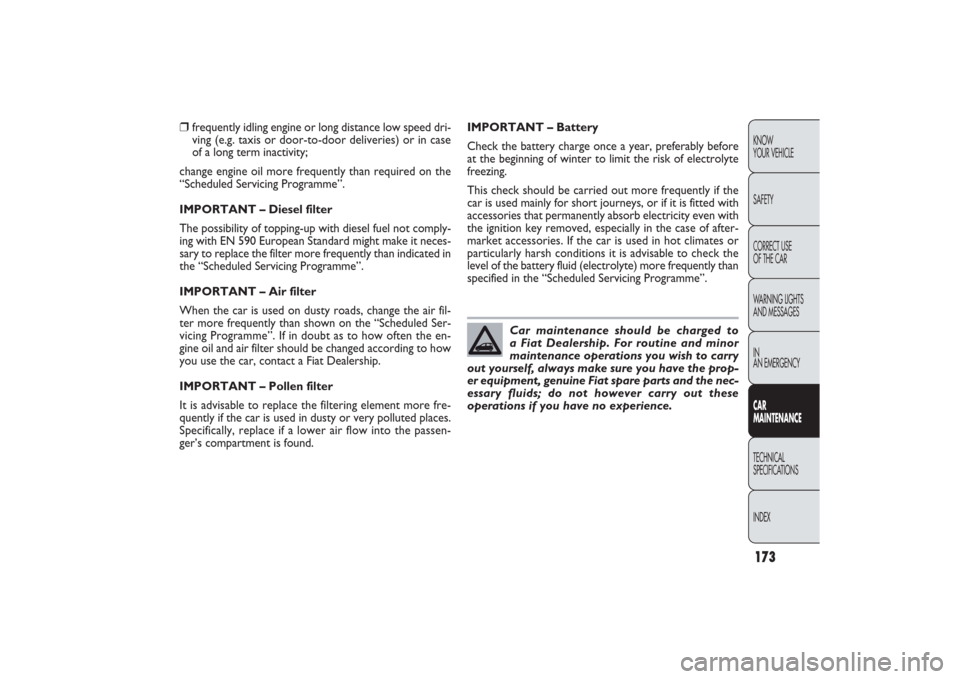
Car maintenance should be charged to
a Fiat Dealership. For routine and minor
maintenance operations you wish to carry
out yourself, always make sure you have the prop-
er equipment, genuine Fiat spare parts and the nec-
essary fluids; do not however carry out these
operations if you have no experience.
IMPORTANT – Battery
Check the battery charge once a year, preferably before
at the beginning of winter to limit the risk of electrolyte
freezing.
This check should be carried out more frequently if the
car is used mainly for short journeys, or if it is fitted with
accessories that permanently absorb electricity even with
the ignition key removed, especially in the case of after-
market accessories. If the car is used in hot climates or
particularly harsh conditions it is advisable to check the
level of the battery fluid (electrolyte) more frequently than
specified in the “Scheduled Servicing Programme”.
❒
frequently idling engine or long distance low speed dri-
ving (e.g. taxis or door-to-door deliveries) or in case
of a long term inactivity;
change engine oil more frequently than required on the
“Scheduled Servicing Programme”.
IMPORTANT – Diesel filter
The possibility of topping-up with diesel fuel not comply-
ing with EN 590 European Standard might make it neces-
sary to replace the filter more frequently than indicated in
the “Scheduled Servicing Programme”.
IMPORTANT – Air filter
When the car is used on dusty roads, change the air fil-
ter more frequently than shown on the “Scheduled Ser-
vicing Programme”. If in doubt as to how often the en-
gine oil and air filter should be changed according to how
you use the car, contact a Fiat Dealership.
IMPORTANT – Pollen filter
It is advisable to replace the filtering element more fre-
quently if the car is used in dusty or very polluted places.
Specifically, replace if a lower air flow into the passen-
ger’s compartment is found.
INDEX TECHNICAL
SPECIFICATIONSCAR
MAINTENANCEIN
AN EMERGENCY WARNING LIGHTS
AND MESSAGES CORRECT USE
OF THE CAR SAFETY KNOW
YOUR VEHICLE173
169-190 PANDA EN 7-10-2009 14:14 Pagina 173
Page 177 of 226

176KNOW
YOUR VEHICLE
SAFETY
CORRECT USE
OF THE CAR
WARNING LIGHTS
AND MESSAGES
IN
AN EMERGENCYCAR
MAINTENANCE
TECHNICAL
SPECIFICATIONS
INDEX
F0Z0184m
fig. 175 – version 1.1
F0Z0262m
fig. 177 – version 1.3 Multijet
F0Z0106m
fig. 176 – version 1.2-1.2 Euro 5 (C)
IMPORTANT The oil consumption depends on driving
style and the car utilisation conditions.
IMPORTANT After adding or changing the oil, let the en-
gine run for a few seconds and wait a few minutes after
switching it off before checking the level. ENGINE OIL fig. 175 – 176 and 177
Check the oil level a few minutes (about five) after the en-
gine has stopped, with the car parked on level ground.
Check the level is within the MIN. and MAX. marks on the
dipstick B.
The range between the MIN. and MAX. marks corre-
sponds to about 1 litre of oil. If the oil level is close to or
actually below the MIN. mark, pour in the prescribed oil
through the filler A until it reaches the MAX mark. The oil
level must never exceed the MAX mark.
ENGINE OIL CONSUMPTIONThe maximum engine oil consumption is usually 400 grams
every 1000 km.
When the car is new, the engine needs to be run in, there-
fore the engine oil consumption can only be considered
stabilised after the first 5,000 ÷ 6,000 km.
169-190 PANDA EN 7-10-2009 14:14 Pagina 176
Page 178 of 226

177KNOW
YOUR VEHICLE
SAFETY
CORRECT USE
OF THE CAR
WARNING LIGHTS
AND MESSAGES
IN
AN EMERGENCYCAR
MAINTENANCETECHNICAL
SPECIFICATIONS
INDEX
F0Z0182m
fig. 179
F0Z0107m
fig. 178
ENGINE COOLANT fig. 178 and 179
The coolant level must be checked when the engine is cold
and must range between the MIN. and MAX. marks on the
reservoir.
If the level is low, pour slowly a mixture of 50% deminer-
alised water and 50% PARAFLU
UP
of FL Selenia through
the filler neck A until approaching the MAX. level.
A 50-50 mixture of PARAFLU
UP
and demineralised wa-
ter gives freeze protection to −35 °C.
For particularly harsh climate conditions, a mixture of 60%
PARAFLU
UP
and 40% demineralised water is recom-
mended.
When the engine is hot, take care when
working inside the engine compartment to
avoid burns. Remember that when the engine is
hot, the fan may cut in: danger of injury. Scarves,
ties and other loose clothing might be pulled by
moving parts.
WARNING
Never add any oil with different specifica-
tions than those of the existing engine oil. Used engine oil and the replaced oil filter
contain substances that may be dangerous
for the environment. It is advisable to have
oil and filters changed by a Fiat Dealership where
they will be disposed respecting the environment
and according to law prescription.
169-190 PANDA EN 7-10-2009 14:14 Pagina 177
Page 179 of 226

The engine cooling system is pressurised.
If necessary, only replace the cap with an-
other genuine one or the operation of the system
may be adversely affected. Do not remove the cap
from the reservoir when the engine is hot: dan-
ger of scalding.
WARNING
The engine cooling system uses protective
antifreeze fluid PARAFLU
UP. Use the same
fluid as in the cooling system when topping
up. PARAFLU
UP
fluid cannot be mixed with any oth-
er type of fluid. If this accidentally occurs, do not
start the engine and contact a Fiat Dealership.
Do not travel with the windscreen wash-
er reservoir empty: the windscreen
washer is fundamental for improving visibility.
WARNING
WINDSCREEN/REAR WINDOW WASHER
FLUID fig. 180
To top-up, remove the cap A.
Pour a mixture of water and TUTELA PROFESSIONAL
SC35, in the following concentrations:
30% TUTELA PROFESSIONAL SC35 and 70% water in
summer.
50% TUTELA PROFESSIONAL SC35 and 50% water in
winter.
At temperatures below −20 °C, use undiluted TUTELA
PROFESSIONAL SC35 fluid.
Check level through the reservoir.
fig. 180
F0Z0183m
INDEX TECHNICAL
SPECIFICATIONSCAR
MAINTENANCEIN
AN EMERGENCY WARNING LIGHTS
AND MESSAGESCORRECT USE
OF THE CARSAFETYKNOW
YOUR VEHICLE
178
169-190 PANDA EN 7-10-2009 14:14 Pagina 178
Page 184 of 226
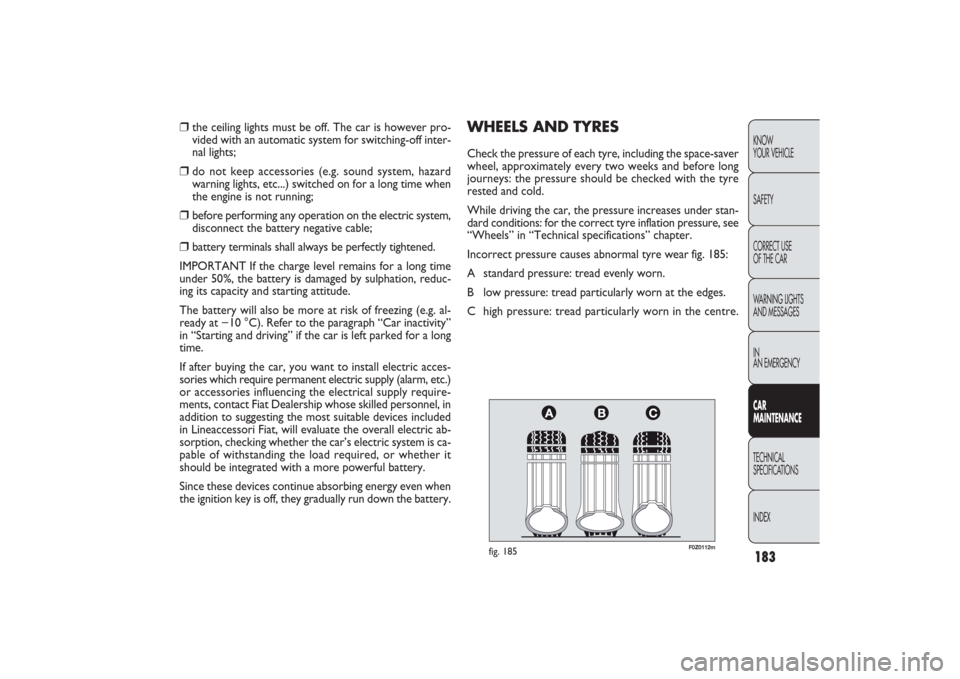
183KNOW
YOUR VEHICLE
SAFETY
CORRECT USE
OF THE CAR
WARNING LIGHTS
AND MESSAGES
IN
AN EMERGENCYCAR
MAINTENANCETECHNICAL
SPECIFICATIONS
INDEX
F0Z0112m
fig. 185
WHEELS AND TYRESCheck the pressure of each tyre, including the space-saver
wheel, approximately every two weeks and before long
journeys: the pressure should be checked with the tyre
rested and cold.
While driving the car, the pressure increases under stan-
dard conditions: for the correct tyre inflation pressure, see
“Wheels” in “Technical specifications” chapter.
Incorrect pressure causes abnormal tyre wear fig. 185:
A standard pressure: tread evenly worn.
B low pressure: tread particularly worn at the edges.
C high pressure: tread particularly worn in the centre.
❒
the ceiling lights must be off. The car is however pro-
vided with an automatic system for switching-off inter-
nal lights;
❒
do not keep accessories (e.g. sound system, hazard
warning lights, etc...) switched on for a long time when
the engine is not running;
❒
before performing any operation on the electric system,
disconnect the battery negative cable;
❒
battery terminals shall always be perfectly tightened.
IMPORTANT If the charge level remains for a long time
under 50%, the battery is damaged by sulphation, reduc-
ing its capacity and starting attitude.
The battery will also be more at risk of freezing (e.g. al-
ready at −10 °C). Refer to the paragraph “Car inactivity”
in “Starting and driving” if the car is left parked for a long
time.
If after buying the car, you want to install electric acces-
sories which require permanent electric supply (alarm, etc.)
or accessories influencing the electrical supply require-
ments, contact Fiat Dealership whose skilled personnel, in
addition to suggesting the most suitable devices included
in Lineaccessori Fiat, will evaluate the overall electric ab-
sorption, checking whether the car’s electric system is ca-
pable of withstanding the load required, or whether it
should be integrated with a more powerful battery.
Since these devices continue absorbing energy even when
the ignition key is off, they gradually run down the battery.
169-190 PANDA EN 7-10-2009 14:15 Pagina 183